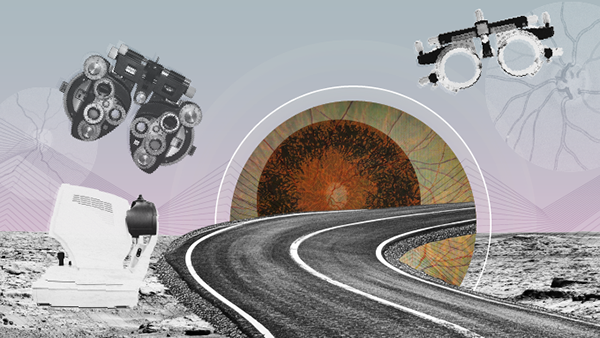You are viewing 1 of your 3 articles before login/registration is required
Embrace Emerging Technology for Success in Practice
How technology feeds my enthusiasm and lets me “do more in less time”
I’m more excited about optometry today than I was when I started 10 years ago. After I finished a residency in advanced ocular disease, I knew that I wanted to practice optometry to my highest skill level. Today, I have a full-service general practice in Cincinnati, Ohio, where we serve all our patients’ needs – from regular exams and refractions to management of retinal disease and glaucoma. We also have a specialty dry eye medspa practice. I love the variety, the challenges, and the problem-solving – all of which keep me engaged and excited.
I’m also deeply engaged in tracking new technologies. I want to dig deeper, get more information, and do more for patients therapeutically without delaying our schedule. In fact, we invest heavily in new technologies, averaging a purchase every six months for the last five years. Some devices are absolutely essential – without OCT, we couldn’t co-manage retina cases or track glaucoma. Other technologies fill an unmet need, speed up a slow process, or allow us to handle some aspect of care that we used to refer out. Here’s how having a high-tech practice is helping optometrists like me offer comprehensive care.
Boosting case volume in primary care
Many optometrists want to see more patients per day without making themselves or the patient feel rushed. In primary care practice, you can streamline the optometrist’s time with patients by using an autorefractor, auto phoropter, and ultra-widefield non-mydriatic fundus imaging (California FA, Optos). With these devices, the patient visit is front-loaded toward the technician. The doctor enters the exam room with diagnostic imaging, spends less time refracting, and saves patient education time with images that let patients see their problems.
In our practice, we do a lot of myopia control. My technician does diagnostic testing, such as current prescription, autorefraction (TopCon) and topography (Keratograph 5M, Oculus). With this information at my fingertips, I complete the myopia control evaluation at the slit lamp and discuss the results with my patient. This approach saves a lot of time, without any negative effects for the patient, my staff, or me.
Driving the dry eye medspa
A medspa for dry eye disease (DED) and aesthetics is high-tech by definition. For DED in particular, I rely on advanced diagnostic technologies, such as InflammaDry (Quidel), the Keratograph 5M, and the TearLab Osmolarity System (Trukera). My technician does all of this testing before I see the patient, so when I come into the exam room, I have a good picture of the problem and I’m ready to discuss it and answer questions. Patients spend twice as much time with the technician as they do with me, but we still have plenty of time to talk, and they enjoy the patient experience.
On the treatment side, I use OptiLight (Lumenis). Lumenis intense pulsed light (IPL) technology is the first and only IPL to be FDA approved for management of DED. Its clinically validated preset program functions make it quick and efficient for me to perform treatment based on the patient’s Fitzpatrick skin type. Results are rapid. Some conventional therapies, such as warm compresses, can take months to have any effect, and often the relief provided is temporary. With OptiLight, I can get to the root cause of DED – reducing inflammation and improving meibomian gland morphology and function (1) – in a series of four treatments spaced a few weeks apart, each of which takes me just 10 minutes. Some patients also have complementary DED therapies, such as thermal pulsation (Systane iLux, Alcon) and radiofrequency treatment (TempSure Envi, Cynosure).
Offering more comprehensive, fee-based testing
In my general practice, we prefer longer appointment times. Advanced technologies let us take our time without any negative effect on revenues. We also offer screening for macular health (Daytona, Optos), meibography (LipiScan, Johnson & Johnson), and antioxidant screening (S3 BioPhotonic Scanner, Pharmanex), which helps me recommend multivitamins. Fees for these optional tests are billed in addition to the regular exam, which patients don’t mind because they like getting a broader picture of their health. These technologies and others contribute to the return on investment for new devices, both directly and in product sales and treatment conversions – especially for DED.
If you want a high-tech practice, don’t be afraid to be a beginner! I always have my eye on the next emerging technology, and I like reaching just outside my comfort zone to keep learning and stay challenged. I think this mindset wards off boredom and burnout.
As you consider which devices to add to your practice, don’t let concerns about learning curves hold you back. Read the literature, watch YouTube, and call your colleagues. Before I invest in a device, I find colleagues around the country who already have it and set up a phone call. People reach out to me for the same reason. We’re always willing to help other “beginners” with the learning curve, whether we need help right away or years later. In my experience, because new devices are easy to use, my technicians and I can implement them quickly so there’s no slow-down in patient flow. Keep your staff involved every step of the way, and you’ll sail through the implementation process while preparing staff for their role in patient education.
Invest judiciously, but don’t be nervous – be excited! Follow the aspects of optometry that grab your interest and help you improve patient care. The more we learn and invest in ourselves and our profession, the stronger we become – and the more we can for our patients.
Reference
- R Toyos et al. “Intense pulsed light improves signs and symptoms of dry eye disease due to meibomian gland dysfunction: A randomized controlled study,” PLoS One, 17 (2022). DOI:10.1371/journal.pone.0270268
The New Optometrist Newsletter
Permission Statement
By opting-in, you agree to receive email communications from The New Optometrist. You will stay up-to-date with optometry content, news, events and sponsors information.
You can view our privacy policy here
Most Popular
Sign up to The New Optometrist Updates
Permission Statement
By opting-in, you agree to receive email communications from The New Optometrist. You will stay up-to-date with optometry content, news, events and sponsors information.
You can view our privacy policy here
Sign up to The New Optometrist Updates
Permission Statement
By opting-in, you agree to receive email communications from The New Optometrist. You will stay up-to-date with optometry content, news, events and sponsors information.
You can view our privacy policy here








